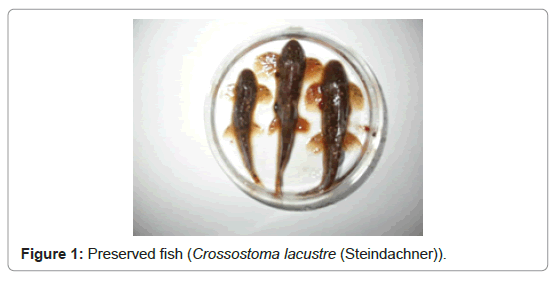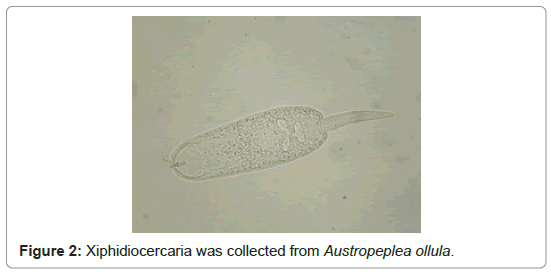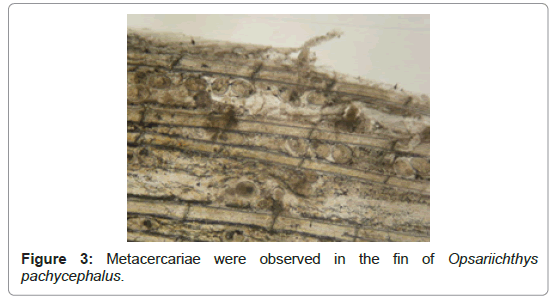Experimental Infection with Xiphidiocercariae and Surveying Aquatic Product infection with Metacercariae
Received: 11-May-2022 / Manuscript No. JIDT-22-63504 / Editor assigned: 13-May-2022 / PreQC No. JIDT-22-63504(PQ) / Reviewed: 27-May-2022 / QC No. JIDT-22-63504 / Revised: 03-Jun-2022 / Manuscript No. JIDT-22-63504(R) / Published Date: 10-Jun-2022
Abstract
The artificial gastric-juice digestive method was used to examine 250 preserved clams, 125 living Corbicula fluminea samples, and 53 preserved fish that were all bought randomly from markets. We did not observe any metacercariae in the products bought from traditional markets. However, this does not indicate that preserved aquatic products can be sold without being cooked because, we observed that self-infected metacercariae survive for 5 minutes after being digested in fish bodies can still at a temperature of 50°C, but survive for only 1 minute when the temperature rises to 80°C. In an experimental infection study, we determined that Corbicula fluminea was not infected with xiphidiocercariae, but the fins of Opsariichthys pachycephalus can be infected and experimental metacercariae were observed. Austropeplea ollula was determined to be the first intermediate host of the xiphidiocercaria parasite, and Opsariichthys pachycephalus is a suitable second intermediate host of trematodes. Therefore, raw or insufficiently cooked, they pass down parasitic diseases.
Keywords: Gie; Metacercaria; Trematode; Opsariichthys pachycephalus
Introduction
Food-borne trematode infection is a global problem [1-6], and causes various clinical infections in humans. Cercaria and metacercaria play an important role in the transmitting cycle of the trematode. There are many secondary hosts in many kinds of aquatic insect larva and freshwater fish [7-9].
Mollusks and crustaceans are important components of the traditional diet in Taiwan. Gie is a preserved food, treated with salts, sugars, rice wines, vinegar, soy-bean sauces, and other condiments to preserve the meat or vegetables in traditional food. Preserved clams and gie are traditional treatments with mixed sources. The pickled food had a special flavor that can promote appetite. Such as the juice of the crushed crayfish had been used as a remedy for measles in Korea [10], Kimchi and crab with wines in Korea and China [10,11]; Salted fish paste was used to prepare raw or half-cooked seafood after treatment with salt in Philippines [12]. The food is most associated with Asian cuisine, which features an assortment of preserved seafood pasta and sauces.
A past report revealed that à woman had never traveled outside the continental United States but became infected while eating raw freshwater fish (sushi) that had been served at a local Japanese restaurant [13]. Since immersion of the infected crustacean host in rice wine or strong brine for a short time will not kill the metacercaria. The infested crustaceans are boiled or fried in deep oil to ensure against infection [11,14,15].
In this study, we attempt to know the parasite infection of the preserved food. In the post paper, metacercaria of Metagonimus yokogawai was determined in the scare of the fresh-water fish, including Opsariichthys pachycephalus, Zacco platypus, Distoechodon turmirostris, Varicorhinus barbatulus, Hemibarbus labeo and Acrossocheilus formosanus in Taiwan [16]. Above all fresh-water fish was cooked with fire. Higher temperatures will kill the metacercaria of the scare. The preserved fish treated with salts, sugars, rice wines, vinegar, and soybean sauces has not killed the metacercaria but can make the delicious foods.
Materials And Methods
Intermediate hosts collection and examination
250 marinated river clams (Crobicula fluminea), 125 living Crobicula fluminea, and 53 preserved fish (Crossostoma lacustre (Steindachner)) (Figure 1) were random collect from traditional markets in Miaoli County, Taiwan. 15 freshwater fish (Opsariichthys pachycephalus) was collected from Dari River, Taichung, Taiwan. O. pachycephalus and other 31 experimental fish C. auratus were anesthesia with ether and examined the fin of the collected freshwater fish under the dissection microscopic to confirm metacercaria-free in the fin of the fishes. Artificial gastric juice was used to collect the metacercacriae.
Cercaria isolation and experimental infection
278 Austropeplea ollula were random sampling from Dakeny stream, Taichung, Taiwan. The light-lamination method was used to recover cercaria from freshwater snails at 25℃ for 2 hr. Recovery cercaria (Figure 2) were used to infect the secondary host including, C. fluminea, O. pachycephalus, and Carassius auratus to confirm the infection recovery rate of the experimental cercaria infection, as the positive control of the activity of isolated cercaria. All experimental secondary intermediate hosts were sacrificed after 3 days postinfection.
Metacercaria isolation
Artificial gastric juice was used to isolate the metacercariae from the experimental secondary intermediate host. Briefly, flesh tissue is cut into small piece and then adds ten times and equal volume of artificial gastric juice is into the flask. The flask was incubated at 25°C, 50°C, and 80°C for 3 to 4 hours and keeps stirring. 300 μm plastic filter was used to remove the residue. The filtered fluid was placed into a 500 ml beaker to which tap water was added and standing for 20 to 30 min. The supernatant was replaced with tap water. The above process was repeated several times until the supernatant was clear and the sediment was observed under a dissection microscopic to collect the metacercariae. Isolated metacercariae were treated at 80°C to evaluate the effect of the temperature.
Results
Samples examination
Non-metacercaria was observed from 250 marinated river clams, 125 live river clams, and 53 preserved fish. The pH of the source of the marinated fluid is 4.7. Diatomaceous was isolated after digestion.
Experimental infection
Non-metacercaria was observed from experimental clams that infect with xiphidiocercaria. The metacercariae were obtained in the fin of the fish and the recovery rate of the metacercaria is 73.3% (11/15) in O. phchycephalus (Figure 3). The recovery rate of the metacercaria is 32.3% (10/31) after day 1 post-infection and 90.3% (28/31) after day 3 post-infection in C. auratus.
Temperature effect
No effect was observed in the metacercaria experiment at 25°C temperature incubation. Metacercarirae keep activate under 50°C for 5 minutes and were surviving only one minute after being treated with 80°C incubation.
Discussion
Trematode infection is a public health problem, particularly in Southeast Asia and the Western Pacific region [3]. The meat of fish can be infected with trematodes [17]. We evaluated the trematode infection of the preserved foods, sampling from the traditional markets and used to exams. Our results showed that non-metacercaria was found in 250 marinated river clams (C. fluminea), 125 living C. fluminea, and 53 preserved fish (Crossostoma lacustre (Steindachner). Metacercaria can break with 80°C heat in the making process of the preserved clams. In order to increase the taste of the delicious clams reserved directly with the live clams, most likely to infect other species of intestinal flukes that an infected people.
On the other hand, the wild clam is already nearly extinct, pickled clams are commercially farmed mostly for breeding sites. In the breeding process, there is little opportunity to come into contact with the intestinal trematode reservoir hosts, including fish-eating birds as well as dogs and cats serve as the reservoir host [16,18], thus reducing the chance of infection by intestinal parasites.
Preserve to the date of manufacture of minced meat inspection has about two and a half months, although the manufacturing process is not cooked, indirect pickled fish, even if there are metacercariae but may also be due to pH, and on a sauce of vinegar, the wine is more sensitive or more term survival of metacercariae died. A previous report showed that boiling the crayfish for 30 seconds or soaking in Japanese soy sauce for about 1 week killed all of the metacercariae [11]. This indicates eating raw pickled foods, the longer its date of manufacture, the less opportunity to be infected, such as the unfortunate buy just made pickled food consumption is likely to be infected.
In a previous study, metacercarial infectivity was recorded in the laboratory-reared C. fluminea exposed to the cercariae of Echinostoma cinetorchis [19]. Although, C. fluminea can be a potential secondary intermediate host of E. cinetorchis. In this study, C. fluminea will become the second intermediate host like this could not be confirmed, but C. fluminea will not be infected with xiphidiocercariae. However, the river clam is not a secondary host of xiphidiocercariae because of its specificity. This has been confirmed in the present study.
In experimental river fish (O. pachycephalus) and C. auratus, we determined that the total infection rate of the metacercariae was 45.7% (21/46) after day 3 post-infection. The metacercaria infection rate of O. pachycephalus was higher than C auratus. We suggested that O. pachycephalus was a suitable intermediate host of fish-borne trematoda. This result was the same as Li (2013) reported for M. yokogawai metacercaria infection. Additionally, infected fins were placed in petri dishes with marinade, the result showed that the fins on the metacercariae killed decomposition after two hours of incubation, similarly to gie mince. However, metacercariae were more sensitive to a sauce of vinegar and wine. The long-term preserved date can avoid infecting the marinated river clams and preserved fish. We suggested that pickled clams and fish in salted boiling water boiled and keeps long-term preserved before diet that can make delicious food and avoid parasite infection [11,15].
Conclusion
Gie is a popular traditional food in many traditional markets due to its unique flavor. Mixed sauces including salt, sugar, rice wine, vinegar, and bean paste can preserve food after pickling. The experiment also confirmed that there is no parasitic infection in the traditional food treated with the mixed sauce. In the experimental fish, it was indeed observed that the cercaria was further developed into metacercaria due to the infection process. On the other hand, if the freshwater fish were raw or insufficiently cooked, the infection of fish-borne parasitic trematodes may be opportunistic happen. Finally, Austropeplea ollula was determined to be the first intermediate host of the xiphidiocercaria parasite, and Opsariichthys pachycephalus is a suitable second intermediate host of trematodes.
Acknowledgements
This work was partially supported by a grant (CTU108-P-101 and CTUST109-P-107) from Central Taiwan University of Science and Technology, Taiwan.
References
- Fried B, Graczyk TK, Tamang L (2004) Food-borne intestinal trematodiases in humans. Parasitol Res 93:159-170.
[Crossref] [Google Scholar] [PubMed]
- Chai JY, Lee SH (2002) Food-borne intestinal trematode infections in the Republic of Korea. Parasitol Int 51:129-154.
[Crossref] [Google Scholar] [PubMed]
- Keiser J, Utzinger J (2005) Emerging foodborne trematodiasis. Emerg Infect Dis 11:1507-1514.
[Crossref] [Google Scholar] [PubMed]
- Fried B, Abruzzi A (2010) Food-borne trematode infections of humans in the United States of America. Parasitol Res 106:1263-1280.
[Crossref] [Google Scholar] [PubMed]
- Chai JY, Van De N, Sohn WM (2012) Foodborne trematode metacercariae in fish from northern Vietnam and their adults recovered from experimental hamsters. Korean J Parasitol 50:317.
[Crossref] [Google Scholar] [PubMed]
- Rim HJ, Sohn WM, Yong TS, Eom KS, Chai JY, et al. (2013) Fishborne trematode metacercariae in luang prabang, khammouane, and saravane province, lao PDR. Korean J Parasitol 51:107-114.
[Google Scholar] [PubMed]
- Ono S (1935) Studies on the life cycle of Plagiorchis sp. (Lepoderma) and Prosthogonimus sp. in North East of China. Hoten Juigaku Kenkyu 4:205-217.
- Radomyos PR, Bunnag DA, Harinasuta TR (1989) A new intestinal fluke, Plagiorchis harinasutai n. sp. Southeast Asian J Trop Med Public Health 20:101-107.
[Google Scholar] [PubMed]
- Hong SJ, Woo HC, Chai JY (1996) A human case of Plagiorchis muris (Tanabe, 1922: Digenea) infection in the Republic of Korea: freshwater fish as a possible source of infection. J Parasitol 82:647-649.
[Crossref] [Google Scholar] [PubMed]
- Choi DW (1990) Paragonimus and paragonimiasis in Korea. Kisaengch'unghak chapchi. Korean J Parasitol 28:79-102.
- Loh IK (1966) Studies on the sources of infection of distomiasis: Part 3. An experimental study on Paragonimus westermani infectiousness of infected fresh-water crayfishes and crabs treated with various cooking methods. Korean J Publ Hlth 3:15-21.
- Tangtrongchitr A, Monzon RB (1991) Eating habits associated with Echinostoma malayanum infections in the Philippines. Southeast Asian J Trop Med Public Health 22:212-216.
[Google Scholar] [PubMed]
- Adams KO, Jungkind DL, Bergquist EJ, Wirts CW (1986) Intestinal fluke infection as a result of eating sushi. Am J Clin Pathol 86:688-689.
[Crossref] [Google Scholar] [PubMed]
- Kim DC (1984) Paragonimus westermani: life cycle, intermediate hosts, transmission to man and geographical distribution in Korea. Arzneimittelforschung 34:1180-1183.
[Google Scholar] [PubMed]
- Lee OY, Nam SY (1977) Effect of NaCl on mortality of metacercariae of Paragonimus westermani with reference to the metacercariae in crabs soaked in soy-bean sauce, Gejang. Rep NIH Korea. 14:203-218.
- Li MH, Huang HI, Chen PL, Huang CH, Chen YH, et al. (2013) Metagonimus yokogawai: metacercariae survey in fishes and its development to adult worms in various rodents. Parasitol Res 112:1647-1653.
[Crossref] [Google Scholar] [PubMed]
- Dorny P, Praet N, Deckers N, Gabriël S (2009) Emerging food-borne parasites. Vet Parasitol 163:196-206.
[Crossref] [Google Scholar] [PubMed]
- Li MH, Liao CW, Lee YL, Ooi HK, Du WY, et al. (2010) Infectivity and development of Metagonimus yokogawai in experimentally infected domestic ducks (Cairina moschata). Vet Parasitol 168:45-50.
[Crossref] [Google Scholar] [PubMed]
- Chung PR, Jung Y, Park YK, Hwang MG, Soh CT (2001) Corbicula fluminea (Bivalvia: Corbiculidae): a possible second molluscan intermediate host of Echinostoma cinetorchis (Trematoda: Echinostomatidae) in Korea. Korean J Parasitol 39:329-332.
[Crossref] [Google Scholar] [PubMed]
Citation: HI, Li MH (2022) Experimental Infection with Xiphidiocercariae and Surveying Aquatic Product infection with Metacercariae. J Infect Dis Ther S3:004.
Copyright: © 2022 Huang HI, et al. This is an open-access article distributed under the terms of the Creative Commons Attribution License, which permits unrestricted use, distribution, and reproduction in any medium, provided the original author and source are credited.
Share This Article
Recommended Journals
Open Access Journals
Article Usage
- Total views: 1617
- [From(publication date): 0-2022 - Nov 21, 2024]
- Breakdown by view type
- HTML page views: 1358
- PDF downloads: 259



